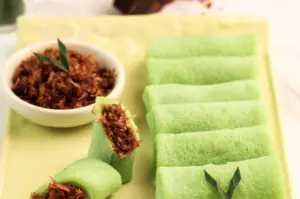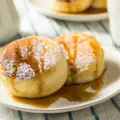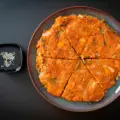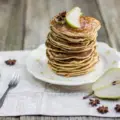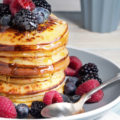Dadar Gulung, also known as rolled pancakes, is a beloved sweet snack in Indonesia. These delectable treats consist of pandan-flavored pancakes filled with a delightful combination of coconut and palm sugar. In this article, we will guide you through the process of making this mouthwatering Indonesian dessert. Get ready to embark on a culinary journey filled with vibrant flavors and unique textures.
Why We Love Dadar Gulung
Dadar Gulung holds a special place in Indonesian cuisine and culture. It is not only a popular street food snack but also a delightful treat to enjoy at home. The bright green color of the pandan-flavored pancakes is visually captivating, and the combination of the fragrant coconut and caramelized palm sugar filling is simply irresistible. Whether you serve them as a tasty snack or an eye-catching dessert, Dadar Gulung is sure to impress your family and friends.
What is Dadar Gulung?
Dadar Gulung translates to “rolled pancake” in Indonesian. These sweet treats are a staple at morning markets throughout Indonesia and are often found alongside other popular delicacies like Klepon, Serabi Kuah, and Kuih Seri Muka. The pancakes themselves are infused with pandan extract and coconut milk, giving them a unique flavor and vibrant green hue. The filling, known as “unti kelapa,” is a decadent mixture of shredded coconut, palm sugar, and pandan leaf. The combination of these flavors creates a harmonious blend of sweetness and tropical goodness.
Ingredients:
For the Crepes (Pancakes):
- 1 cup all-purpose flour
- 1/2 cup fresh pandan juice (you can blend pandan leaves with water and strain)
- 1 1/4 cups coconut milk
- 2 large eggs
- 1/4 teaspoon salt
- Green food coloring (optional)
For the Filling:
- 1 cup grated fresh coconut (or desiccated coconut, rehydrated with warm water)
- 1 cup palm sugar (gula melaka), grated or chopped
- 1/4 cup water
- A pinch of salt
Dadar Gulung Recipe
Step 1: Prepare the Filling
In a saucepan, combine the grated coconut, palm sugar, water, and a pinch of salt.
Cook the mixture over low to medium heat, stirring constantly until the palm sugar has melted and the mixture becomes slightly sticky and well combined.
Once the filling has thickened slightly, remove it from the heat and let it cool down to room temperature.
Step 2: Make the Crepes (Pancakes)
In a mixing bowl, whisk together the all-purpose flour, pandan juice, coconut milk, eggs, and salt until you get a smooth batter.
If you want a more vibrant green color, add a few drops of green food coloring to the batter and mix well.
Heat a non-stick skillet or crepe pan over medium heat and lightly grease it with oil or butter.
Pour a small amount of the batter onto the pan, swirling it around to form a thin, even crepe.
Cook the crepe for about 1-2 minutes on each side until it’s lightly golden. Repeat the process to make more crepes with the remaining batter.
Step 3: Fill the Crepes
Place one crepe on a clean working surface with the cooked side facing down.
Spoon a portion of the sweet coconut filling onto one side of the crepe, leaving some space at the edges.
Carefully fold the sides of the crepe over the filling, then roll it up tightly to form a cylinder or a rectangular shape. Repeat with the remaining crepes and filling.
Step 4: Serve
Once all the Dadar Gulung are assembled, you can serve them as is, or you can slice them diagonally into smaller pieces for a more bite-sized presentation.
You can dust the Dadar Gulung with powdered sugar for a finishing touch, or serve them with some additional grated coconut on top.
Tips for Perfect Dadar Gulung
- When spooning the coconut filling onto the pancakes, give it a gentle mix to ensure that the sugar syrup is evenly distributed.
- Fill and roll the pancakes immediately to prevent them from sticking or tearing once they cool down.
- If your palm sugar is hard, soften it by microwaving it in short bursts of 10-20 seconds at a time.
- Experiment with variations by adding a stick of cinnamon to the coconut filling for an extra burst of flavor.
FAQs About Dadar Gulung
Q: Why is my pancake sticking to the pan? A: Your pan may not be non-stick enough, or you may need to use a little more oil to prevent sticking.
Q: Why does my Dadar Gulung tear when I roll it? A: The pancake may be too thick. Try adding more water to the batter, spreading it evenly in the pan, and cooking it for a longer time until it turns a darker shade of green.
Q: What type of coconut should I use? A: You can use fresh, dried, or frozen coconut. Shredded, grated, or desiccated coconut works well in this recipe.
Variations of Dadar Gulung
While the classic Dadar Gulung recipe is already a delicious treat, you can also experiment with different flavors and fillings to suit your taste preferences. Here are a few variations you can try:
- Coklat Pisang Dadar Gulung: Replace the coconut filling with sliced bananas and flavor the pancakes with chocolate or cocoa.
- Different Types of Palm Sugar: Try using gula melaka, gula jawa, coconut sugar, or brown sugar as alternatives to palm sugar.
- Cinnamon Twist: Add a stick of cinnamon to the coconut filling while cooking for an extra layer of flavor.
